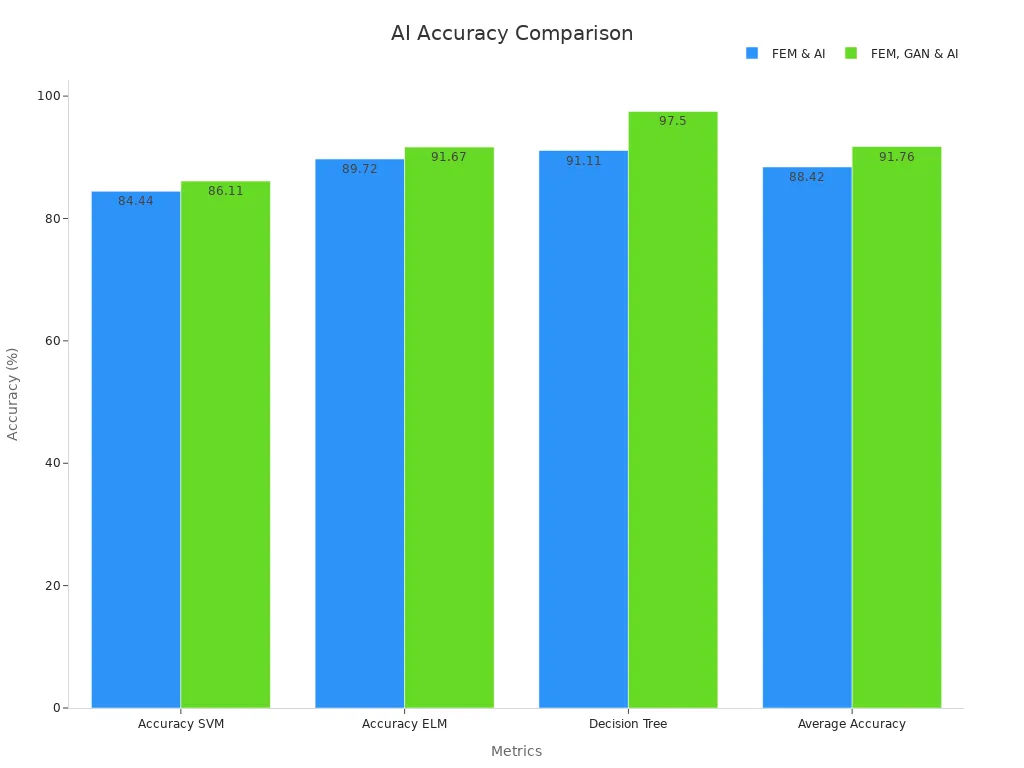
New technologies in artificial intelligence are transforming how you create and innovate. AIGC combines advanced AI systems with human creativity, enabling you to produce unique content faster. These technologies enhance your ability to explore new ideas and push the boundaries of creativity. AIGC and human creativity together are reshaping industries with fresh possibilities.
Key Takeaways
-
AIGC mixes AI with human ideas to make unique content quickly.
-
Big Language Models (LLMs) help by giving new ideas and creative outputs. They are useful in many fields.
-
Multimodal AI tools combine text, pictures, and sounds to make fun content. This helps improve shopping and healthcare experiences.
Generative AI Models Driving AIGC

Large Language Models (LLMs) and Their Role in Creativity
Large Language Models (LLMs) have revolutionized how you approach creativity in the digital age. These advanced systems, powered by artificial intelligence, can generate diverse outputs such as poems, songs, and even novels. By analyzing vast datasets, LLMs identify patterns and produce content that feels human-like. This capability allows you to explore new creative possibilities, whether you're crafting a story or developing marketing campaigns.
One of the key advancements in LLMs is the integration of reinforcement learning from human feedback (RLHF). This technique enhances the ability of LLMs to produce outputs that meet criteria like novelty, surprise, and value. For example, when you use an LLM to brainstorm ideas, it can suggest unique concepts that might not have occurred to you otherwise. This makes LLMs invaluable tools for boosting creativity across industries.
The impact of LLMs extends beyond individual users. Businesses leverage these models to streamline content creation processes, saving time and resources. Whether you're in publishing, advertising, or education, LLMs can help you generate high-quality content tailored to your audience's needs.
-
Key benefits of LLMs in creativity:
-
Generate innovative ideas quickly.
-
Enhance storytelling with engaging narratives.
-
Support multilingual content creation for global reach.
-
Multimodal AI Systems for Diverse Content Generation
Multimodal AI systems take creativity to the next level by combining data from multiple sources, such as text, images, and audio. These systems enable you to create diverse types of content, from visually stunning graphics to detailed video captions. By integrating various data modalities, multimodal AI ensures that the content you produce is both engaging and contextually accurate.
For instance, in e-commerce, multimodal AI can analyze product images and generate compelling descriptions. This improves the shopping experience for your customers by providing them with detailed and accurate information. Similarly, in healthcare, these systems integrate medical data like MRI scans and patient histories to enhance diagnostic accuracy. This versatility makes multimodal AI a cornerstone of modern AIGC technology.
Here’s a table showcasing real-world applications of multimodal AI:
|
Application Area |
Description |
|---|---|
|
E-commerce |
Generates product descriptions based on images, enhancing online shopping. |
|
Healthcare |
Integrates medical data for accurate diagnoses, especially in oncology. |
|
Energy Sector |
Synthesizes operational data to improve efficiency and sustainability. |
|
Video Captioning |
Creates text descriptions for videos, boosting accessibility. |
The growing adoption of multimodal AI is also driving market growth. According to recent data, the generative AI market is projected to grow from USD 14.61 billion in 2024 to USD 63.06 billion by 2033, with a compound annual growth rate of 17.49%. This rapid expansion highlights the increasing demand for advanced AIGC applications across industries.

As you explore the potential of multimodal AI, you'll find that it opens up endless possibilities for innovation. From creating personalized content to improving operational efficiency, these systems empower you to achieve more with less effort.
Advanced Visual Content Creation with AIGC

AI-Powered Image and Video Generation
AI-powered tools are transforming how you create images and videos. These technologies analyze patterns in existing data to generate realistic visuals. For example, generative video models can produce lifelike videos by learning from large datasets. Text-to-video systems, like OpenAI's Sora and Meta AI's Make-A-Video, allow you to create video sequences from simple text descriptions. This makes it easier to bring your ideas to life without requiring advanced technical skills.
Other innovations include image-to-video models, which convert static images into dynamic video sequences. Tools like MocoGAN and Vid2Vid excel in this area. Video-to-video techniques enhance video quality by improving resolution and smoothing transitions between frames. Novel view synthesis methods, such as Neural Radiance Fields (NeRF), generate new perspectives from existing images, giving you more creative control. AI-enhanced content tools also modify visuals through super resolution and denoising, ensuring high-quality outputs.
These advancements make AIGC in graphic design more accessible and efficient. Whether you're creating promotional videos or designing interactive content, AI-powered tools save time and expand your creative possibilities.
Applications in Entertainment and Marketing
AIGC is revolutionizing entertainment and marketing by streamlining production and enhancing user engagement. In the U.S., the AI market in media and entertainment is projected to grow at a compound annual growth rate (CAGR) of 11.6% over the next decade. Globally, this market is expected to reach $44.08 billion by 2028, growing at a CAGR of 25.7%. These figures highlight the increasing demand for AI-driven solutions.
Major companies like Netflix, Spotify, and Disney use AI to personalize content recommendations and optimize workflows. For example, AI-generated music and films allow you to deliver unique experiences to your audience. In marketing, AI applications include creating targeted advertisements and analyzing consumer behavior. These tools help you connect with your audience more effectively while reducing production costs.
By leveraging AIGC in graphic design, you can create visually appealing campaigns that resonate with your target audience. The integration of AI in these industries not only boosts efficiency but also opens new avenues for creativity.
AIGC in Creative Writing and Storytelling
Enhancing Content Creation with AI
AIGC is transforming how you approach creative writing by streamlining processes and enhancing creativity. Artificial intelligence generated content tools can analyze extensive research, create outlines, and draft meaningful content faster than a human. This efficiency allows you to focus on refining ideas and producing high-quality outputs. For example, marketers use AI tools like ChatGPT to generate scripts, articles, and product descriptions tailored to their brand voice. These applications simplify workflows and ensure consistency across multiple projects.
AI also improves storylines and facilitates advancements in visual and audio effects. By suggesting topics and generating rough drafts, it helps you scale content production while maintaining originality. AIGC and human creativity together enable you to craft narratives that resonate deeply with audiences.
Quantitative assessments further highlight the benefits of AIGC in creative writing. Here’s a table summarizing key dimensions:
|
Dimension |
Description |
|---|---|
|
Novelty |
Assesses originality and innovation in the creative process, crucial for unique narrative techniques. |
|
Relevance |
Evaluates the practical applicability of creative solutions in relation to the intended context. |
|
User Experience |
Measures engagement effectiveness, considering authenticity and audience connection. |
|
Sustainability |
Considers long-term viability of creative outputs, factoring in environmental and cultural relevance. |
These metrics demonstrate how AIGC enhances your ability to produce engaging and sustainable content.
Revolutionizing Scriptwriting and Journalism
AIGC is revolutionizing scriptwriting and journalism by enabling faster and more efficient content creation. AI tools can quickly generate outlines, suggest topics, and draft articles, saving you time and effort. For scriptwriters, AIGC applications offer innovative ways to develop characters and plotlines. You can use AI to explore alternative story arcs or refine dialogue, ensuring your scripts captivate audiences.
In journalism, AI analyzes large datasets to uncover trends and insights. This helps you craft articles that are both informative and engaging. By automating repetitive tasks, AIGC allows you to focus on delivering meaningful content that connects with readers.
The integration of AIGC and human creativity in these fields opens new possibilities for storytelling. Whether you’re writing a screenplay or reporting on current events, AI empowers you to produce content that is both impactful and efficient.
Real-Time Personalization Through AI
AI-Driven Recommendation Systems
AI-driven recommendation systems have transformed how you interact with digital platforms. These systems analyze your preferences and behaviors to deliver personalized suggestions, whether you're streaming a movie, shopping online, or exploring music. For example, platforms like Netflix and Spotify use advanced machine learning algorithms to recommend content tailored to your tastes. Netflix, by analyzing viewing habits and preferences, drives over 75% of viewer activity through recommendations, saving an estimated $1 billion annually. Similarly, Spotify curates playlists based on your listening history, enhancing your music discovery experience.
To ensure these systems perform effectively, developers rely on key metrics. These include latency trends, which monitor response times, and recommendation success rates, which measure how often users engage with suggested content. Error spikes also help identify potential issues in the system. Testing processes, such as functional and integration testing, validate the reliability of these systems. Collaborative testing sessions further refine their performance by addressing edge cases and unexpected user behaviors.
|
Metric |
Description |
|---|---|
|
Latency trends |
Monitors if requests are slowing down over time. |
|
Recommendation success rates |
Measures user engagement with personalized content. |
|
Error spikes |
Identifies emerging failure patterns in the system. |
These systems not only improve efficiency but also create a seamless experience for you, making them essential in modern mobile AIGC services.
Improving User Experiences Across Platforms
AI enhances user experiences by personalizing interactions across platforms. It analyzes your browsing history, preferences, and habits to suggest relevant content. Streaming platforms recommend movies or songs based on your viewing patterns, while e-commerce sites provide tailored product suggestions. This level of personalization ensures that your experience feels intuitive and engaging.
Mobile AIGC applications take this a step further by integrating AI into everyday tools. For instance, AI-based design focuses on user behavior, improving accessibility and satisfaction. A survey revealed that organizations prioritizing customer experience see three times the revenue growth. Additionally, personalization can deliver up to 800% ROI on marketing spend while boosting sales by 10%.
By leveraging mobile AIGC, businesses can create dynamic and adaptive platforms that cater to your unique needs. Whether you're using mobile AIGC services for shopping, entertainment, or communication, these applications ensure a more enjoyable and efficient experience.
Ethical and Responsible Development of AIGC
Addressing Bias and Ensuring Fairness
Bias in AIGC systems can lead to unfair outcomes, affecting the reliability of applications across industries. You can address these challenges by focusing on fairness during development. Statistical analyses play a key role in uncovering bias. For example:
-
Data analysis examines training datasets for demographic disparities.
-
Fairness metrics assess equality of opportunity and identify discriminatory outcomes.
-
Human evaluation involves experts manually reviewing outputs to detect biases missed by automated methods.
To reduce bias, you can use strategies like data augmentation to balance representation across different groups. Fairness-aware algorithms also help by considering equity during training. Explainable AI (XAI) provides insights into decision-making processes, allowing you to pinpoint sources of bias.
By integrating these methods into your digital infrastructure, you can ensure that AIGC systems deliver fair and inclusive results. This approach strengthens trust in network automation and enhances the reliability of content generated by AI.
Tip: Regularly updating training datasets and involving diverse stakeholders in the evaluation process can further improve fairness in AIGC applications.
Transparency and Accountability in AI Systems
Transparency and accountability are essential for building trust in AIGC systems. You can achieve transparency by documenting training data sources and methodologies systematically. Explainable AI (XAI) serves as a critical tool for clarifying how decisions are made, helping you understand the infrastructure behind AI systems.
Stakeholder engagement is another key element. Collaborating with ethics experts, technical specialists, and users ensures that transparency mechanisms are culturally relevant and practically useful. To establish accountability, you can implement systematic audits to identify areas for improvement.
Here’s a step-by-step approach to enhance transparency and accountability:
-
Document data collection processes and acknowledge biases.
-
Conduct regular audits to evaluate system performance and fairness.
-
Collaborate continuously with stakeholders to translate transparency principles into actionable practices.
By prioritizing transparency and accountability, you can create AIGC applications that align with ethical standards. This integration not only improves user trust but also ensures the long-term sustainability of AI-driven systems.
Industry-Specific Applications of AIGC
Healthcare: AI-Generated Diagnostics and Reports
AI-generated diagnostics and reports are transforming healthcare by improving accuracy and efficiency. These tools analyze medical data, such as imaging scans and patient histories, to assist doctors in making precise diagnoses. For example, AI systems act as a “second pair of eyes” for radiologists, identifying abnormalities that might be missed during manual reviews. This collaboration enhances diagnostic accuracy and reduces errors.
AI also accelerates the diagnostic process. By automating image analysis, it shortens turnaround times, enabling quicker treatment decisions. In emergency settings, AI-driven triage systems prioritize critical cases, optimizing response times and saving lives. Additionally, AI algorithms predict patient trajectories, allowing for early interventions and personalized care plans.
|
Evidence Type |
Description |
|---|---|
|
AI tools have shown potential to enhance the accuracy of disease detection. |
|
|
Faster Turnaround Times |
Reduced time for image analysis, allowing for quicker diagnoses. |
|
Support for Radiologists |
AI acts as a ‘second pair of eyes,' assisting radiologists in their work rather than replacing them. |
AI's role in the drug discovery process is another groundbreaking application. By analyzing vast datasets, AI identifies potential drug candidates faster than traditional methods. This accelerates the development of life-saving medications while reducing costs.
Note: AI in healthcare doesn't replace professionals. Instead, it empowers them to deliver better care by providing actionable insights.
Finance: Automated Insights and Predictive Analytics
In finance, AIGC applications are revolutionizing how you manage data and make decisions. AI systems analyze large datasets to generate automated insights, helping you identify trends and opportunities. For instance, banks use AI to streamline loan processing and detect fraud, saving time and reducing operational costs.
Predictive analytics enhances risk management by assessing creditworthiness with greater accuracy. This reduces loan defaults and improves profit margins. AI also personalizes financial products, tailoring them to individual customer needs. This approach increases customer satisfaction and drives revenue growth.
-
Key benefits of AI in finance:
-
Increased Efficiency and Cost Savings: Automates processes like fraud detection and loan approvals.
-
Improved Risk Management: Enhances credit assessments, reducing financial risks.
-
Enhanced Revenue Generation: Identifies new business opportunities through personalized services.
-
By leveraging these capabilities, you can make informed decisions and stay ahead in a competitive market.
Telecommunications: AI-Enhanced Communication Tools
AI-enhanced communication tools are reshaping the telecommunications industry. These tools optimize network performance, ensuring seamless connectivity for users. For example, AI agents manage 5G network slicing, tailoring network resources to specific application requirements. This improves efficiency and reduces latency.
Telefónica's AI-based monitoring system exemplifies the impact of AI in telecommunications. By analyzing over 500 million network events daily, the system reduces network incidents by 30%. Predictive maintenance further minimizes downtime and lowers maintenance costs by up to 30%.
-
Key advancements in AI for telecommunications:
-
Comprehensive network health analysis using multiple data sources.
-
Predictive maintenance to prevent outages and improve reliability.
-
Enhanced user experiences through optimized network performance.
-
These innovations ensure that you enjoy faster, more reliable communication services.
E-commerce: Personalized Shopping Experiences
In e-commerce, AIGC applications create personalized shopping experiences that cater to your preferences. AI analyzes your browsing history, purchase patterns, and product interactions to recommend items you'll love. This level of personalization enhances your shopping journey and increases satisfaction.
AI also improves product descriptions and visuals. For instance, multimodal AI systems generate detailed descriptions based on product images, making it easier for you to make informed decisions. Retailers use AI to optimize inventory management, ensuring that popular items remain in stock.
|
Description |
|
|---|---|
|
High-Quality Data |
Access to top-tier datasets including pricing, research reports, and news. |
|
Verifiable Output |
Each result includes source information for easy verification. |
|
Multi-Language Support |
The assistant can answer in multiple languages and across various asset classes. |
|
Flexible Deployment |
Options for both cloud and on-premises deployment to meet specific needs. |
By integrating AI into their operations, e-commerce platforms deliver tailored experiences that keep you coming back for more.
Advancements in AIGC technologies have reshaped how you approach creativity. These tools amplify human creativity, enabling you to produce innovative content across industries. Ethical development ensures fairness and transparency, fostering trust in AIGC systems. The future of AIGC promises emerging trends like adaptive AI and challenges like bias mitigation. You can expect exciting possibilities ahead.
FAQ
What is AIGC, and how does it differ from traditional AI?
AIGC focuses on generating creative content like text, images, and videos. Traditional AI primarily analyzes data and automates tasks without producing original content.
How can AIGC improve your productivity?
AIGC automates repetitive tasks, generates ideas, and drafts content quickly. You can focus on refining outputs and exploring new creative possibilities.
Is AIGC safe to use in sensitive industries like healthcare?
Yes, AIGC tools undergo rigorous testing to ensure accuracy and reliability. They assist professionals without replacing human expertise, enhancing decision-making processes.





